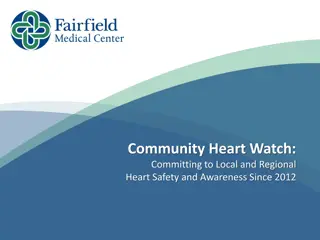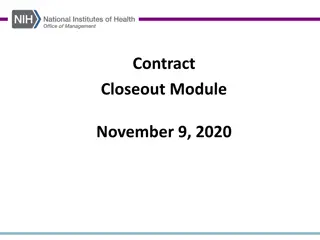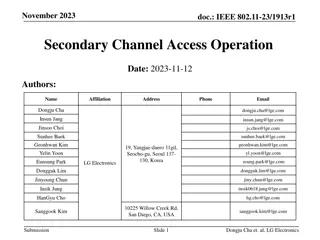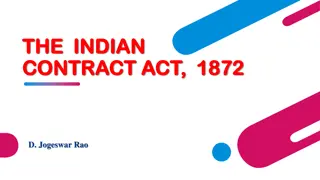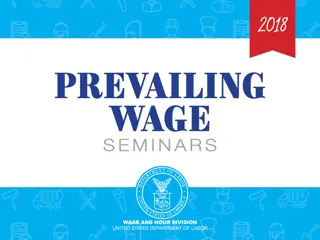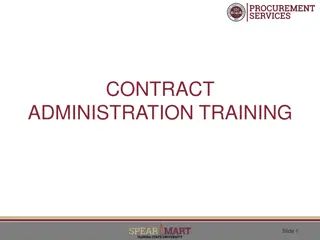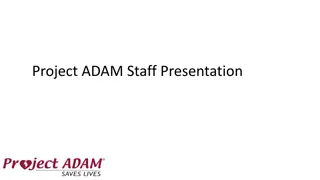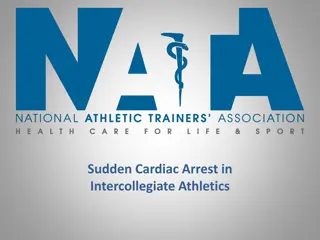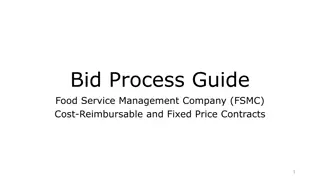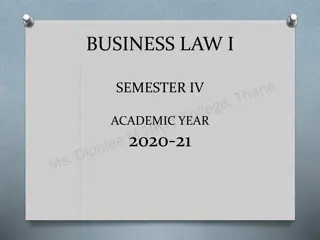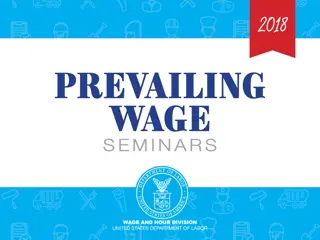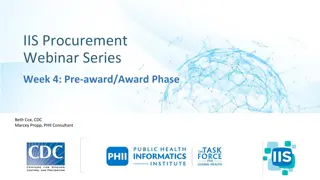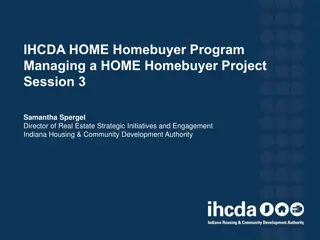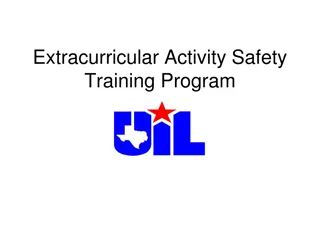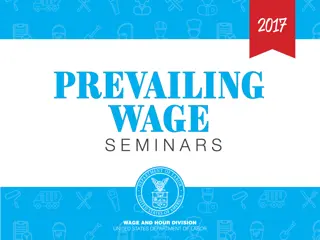Understanding the Service Contract Act (SCA) and its Requirements
The Service Contract Act (SCA) applies to federal contracts over $2,500 that involve service provision in the US, outlining labor standards, wage determinations, and employee classifications. Covered contracts must adhere to regulations set by the Department of Labor, including minimum wages, benefits, and safety provisions. The SCA does not limit the types of services that can be contracted for, encompassing a wide range from security to janitorial services. Obtaining wage determinations is crucial for compliance, with specific guidelines on how agencies can acquire and update them as needed.
Download Presentation

Please find below an Image/Link to download the presentation.
The content on the website is provided AS IS for your information and personal use only. It may not be sold, licensed, or shared on other websites without obtaining consent from the author. Download presentation by click this link. If you encounter any issues during the download, it is possible that the publisher has removed the file from their server.
E N D
Presentation Transcript
SCA Coverage Defined The Service Contract Act applies to any contract that (1) is made by the Federal Government, (2) involves an amount exceeding $2,500, and (3) has as its principal purpose the furnishing of services in the United States (4) through the use of service employees. 41 U.S.C. 6702(a).
Requirements of SCA (29 C.F.R. 4.6) Covered contracts in excess of $2,500 must contain labor standards clauses and: Minimum monetary wages and fringe benefits determined by Department of Labor (DOL) Recordkeeping - Posting requirements Safety and health provisions Statement of rates paid to federal employees
Contracts to Furnish Services (29 C.F.R. 4.111 & 4.130) The SCA does not define or limit the types of services that may be contracted for. Examples of service contracts: Security and guard services Janitorial services Cafeteria and food services Support services at Government installations
Use of service employees (29 C.F.R. 4.113) Section 8(b) of SCA defines service employee as: Any person engaged in performance of contract, except Employees who qualify for exemption as bona fide executive, administrative or professional employees under the FLSA (29 C.F.R. Part 541) Employee coverage does not depend on contractual relationship (29 C.F.R. 4.155)
Wage Determinations Sections 2(a)(1) and (2) of SCA provide that covered contracts in excess of $2,500 contain a wage determination: 2(a)(1) Wages. 2(a)(2) Fringe Benefits Two types of wage determinations, prevailing and section 4(c)
Obtaining Wage Determinations (29 C.F.R. 4.4, 4.143 4.145) Agencies must obtain a new WD at least once every two years. A new WD may be required each year if: The contract is subject to annual appropriations; or An annual contract option being exercised. Most contract extensions, even if shorter than one year, require a new WD. Regulations no longer require Agencies to submit Standard Form (SF-98) or an Electronic (e) 98 to obtain a WD. Agencies have the option to download a WD directly from the website, or submitting an e98 to DOL at www.wdol.gov.
SCA Directory of Occupations Contains standard position descriptions for most SCA occupations listed on prevailing WDs. Contains Federal Grade equivalencies. If a WD occupation is not listed in the Directory, the position description may be included on WD.
Conformances Process for adding missing classifications to a WD Work must not be performed by a class on WD; Proposed rate must bear a reasonable relationship to those listed on WD: No single formula; Look at comparable classes on WD; No specific analytical process to determine conformable rate. The contractor prepares the conformance request (SF 1444 or other format) and submits it to the contracting agency no later than 30 days after the employee begins performing work on the contract. Contracting agency reviews the request, makes a recommendation, and submits it to DOL for final action through wdol.gov
Conformances Conformances may not be used to: Artificially subdivide classes listed in WD; Combine two or more classes listed in WD to create a new class; Establish a job level lower than lowest level listed in WD for a job classification family (Computer Operator I through V); or Establish helper and trainee classifications.
SCA Compliance Principles Payment of wages Payment of fringe benefits Vacation Fringe Benefits Holiday Fringe Benefits Deductions Recordkeeping Notice to employees
Payment of Wages (29 C.F.R. 4.165) Wages established by wage determination, otherwise FLSA minimum wage (29 C.F.R. 4.165(c)) Monetary wages to be paid when promptly due (29 C.F.R. 4.165(a)(1)) No distinction between Full and Part Time Employees(29 C.F.R. 4.165(a)(2)) Calculated on fixed and regularly recurring workweek of 7 consecutive 24-hour workday periods (29 C.F.R. 4.165(b)) Payroll records kept on this basis Bi-weekly or semi-monthly pay periods if advance notice
Wage Payments for Work Subject to Different Rates Employee must be paid: Highest rate for all hours worked; unless Employer s payroll records or other affirmative proof show periods spent in each class of work. Applies when employee works part of workweek on SCA-covered and non-SCA-covered work.
Payment of Fringe Benefits Cash payments in lieu of fringe benefits (FBs) must be paid on regular pay date (29 C.F.R. 4.165(a)). Payments into bona fide FB plans must be made no less often than quarterly (29 C.F.R. 4.175(d)). FB costs may not be credited toward wage requirements (29 C.F.R. 4.167). The contractor also may not credit excess wage payments against the FB obligation.
Health & Welfare Fringe Benefits Prevailing WDs provide a H&W footnote. All occupations listed on the WD receive benefits as specified. Three types of FB requirements: Fixed cost per employee benefits; Average cost benefits; or Collectively bargained (CBA) benefits. Types and amounts of benefits and eligibility requirements are contractor s prerogative.
Vacation Fringe Benefits (29 C.F.R. 4.173(c)(1)) Are vested and become due after the employee s anniversary date. Need not be paid immediately after the anniversary date, but must be discharged before (whichever occurs first): The next anniversary date; The completion of the contract; or The employee terminates employment
Holiday Fringe Benefits (29 C.F.R. 4.174) An employee is entitled to holiday pay if he/she works in the holiday workweek. An employee is not entitled to holiday pay if the holiday not named in the WD (i.e., government closed by proclamation). Paid holidays can be traded for another day off if communicated to employees.
Recordkeeping 29 CFR 4.6(g) Contractors shall make and maintain for 3 years from the completion of the work records containing the following information: Name and address and social security number of each employee The correct work classification or classifications, rate or rates of monetary wages paid and fringe benefits provided, rate or rates of fringe benefit payments in lieu thereof, and total daily and weekly compensation of each employee The number of daily and weekly hours so worked by each employee
Recordkeeping 29 CFR 4.6(g) Any deductions, rebates, or refunds from the total daily or weekly compensation of each employee A list of monetary wages and fringe benefits for those classes of service employees not included in the wage determination attached to this contract but for which such wage rates or fringe benefits have been conformed Any list of the predecessor contractor's employees which had been furnished to the contractor pursuant to 4.6(l)(2).
SCA Investigations DOL has sole enforcement authority under SCA. WHD may conduct investigations for a number of reasons: Typically, reason is not disclosed. Many are initiated by complaints. Complaints are confidential.
SCA Investigations An investigation will generally identify and examine the following issues: Are SCA stipulations and correct WD included in the contract? Are the SCA poster and WD, including any conformance actions, posted at the site or made available to employees? Does the WD contain necessary classifications? Is a conformance necessary? Are employees properly classified? Are fringe benefits being properly paid? Is overtime correctly paid under the FLSA or CWHSSA, if appropriate? Has employer kept accurate payroll records?
Investigative Process Initial conference with employer. Examine certified payrolls. Examine basic payroll records. Check for compliance with apprenticeship and/or trainee requirements. Interview employees Determine if a conformance is necessary. Compute back wages and liquidated damages, if any Final conference with
Withholding of Contract Funds Withholding of Contract Funds (29 C.F.R. 4.6(i) & 4.187) SCA and CWHSSA provide for withholding of contract funds to satisfy alleged wage underpayments pending resolution of a wage dispute. 41 U.S.C. 352(a); 40 U.S.C. 3702(d). Withholding of contract funds is an effective enforcement tool in SCA and CWHSSA cases. It protects the rights of covered workers to wages due them.
Withholding of Contract Funds FAR (48 C.F.R. Part 22) FAR guidance in 48 C.F.R. Part 22 instructs that if the contracting officer believes a violation exists, or upon request of the Department of Labor: the contracting officer must withhold from payments due the contractor an amount equal to the estimated wage underpayment and estimated liquidated damages due under the CWHSSA. 48 C.F.R. 22.406-9(a).
Withholding of Contract Funds FAR (48 C.F.R. Part 22) If subsequent investigation confirms violations, the contracting officer must adjust the withholding as necessary. If DOL requested the withholding, the contracting officer must not reduce or release the withheld funds without written approval by DOL. The withheld funds are to be used to satisfy: assessed liquidated damages; and unless the contractor makes restitution, validated wage underpayments.
Disposition of Withheld Funds The WHD RO will request the contracting agency to transfer the withheld funds: When a contractor agrees to distribution of contract funds to the covered workers (whether or not they have been subject to a formal withholding process); or When a contractor (the prime contractor or subcontractor) does not timely request a hearing pursuant to 29 C.F.R. 5.11(b); or Following the issuance of ALJ decisions, including decisions approving settlement agreements; or Following issuance of ARB decisions; or Subsequent to final resolution of further litigation.
Debarment (41 U.S.C. 354; 29 C.F.R. 4.188) Any person or business entity found to have violated the SCA may be ineligible to receive further contracts for three years unless there is a finding of unusual circumstances. GSA's System for Award Management (SAM) reflects debarred firms by name/address.
Debarment (41 U.S.C. 354; 29 C.F.R. 4.188) The burden is on the contractor to demonstrate unusual circumstances. A good compliance history, cooperation in the investigation, repayment of moneys due, and sufficient assurances of future compliance are prerequisites, but are not the only factors that must be considered. Debarment relief is not appropriate where aggravated circumstances are present, such as willful, deliberate, or aggravated violations, or culpable neglect or disregard of the requirements of the labor provisions
Hearing Process (29 C.F.R. Part 6) A complaint is filed by WHD with DOL s Administrative Law Judge (ALJ) when a contractor: Fails to pay back wages; or Refuses to agree to future compliance; or Debarment is recommended. The contractor served with a copy of the complaint. The Office of the Chief ALJ is responsible for scheduling administrative hearings. ALJ decisions may be appealed (within 40 days) to the Administrative Review Board, which makes final agency rulings.
Administrative Review Board (29C.F.R. Part 8) Members appointed by the Secretary of Labor. Hears appeals of ALJ decisions. Acts on petitions to review final rulings of WHD Administrator: 60 days on coverage & interpretations; 20 days on WD matters. Proceeding may be an oral hearing or by review of the record in closed session.
Internet Sites Wage Determinations http://www.wdol.gov Wage and Hour Division - http://www.dol.gov/whd/index.htm Resource Book - http://www.dol.gov/whd/recovery/pwrb/toc.htm Office of the Administrative Law Judges Law Library - http://www.oalj.dol.gov Administrative Review Board - http://www.dol.gov/arb
Disclaimer This presentation is intended as general information only and does not carry the force of legal opinion. The Department of Labor is providing this information as a public service. This information and related materials are presented to give the public access to information on Department of Labor programs. You should be aware that, while we try to keep the information timely and accurate, there will often be a delay between official publications of the materials and the modification of these pages. Therefore, we make no express or implied guarantees. The Federal Register and the Code of Federal Regulations remain the official source for regulatory information published by the Department of Labor. We will make every effort to keep this information current and to correct errors brought to our attention.


